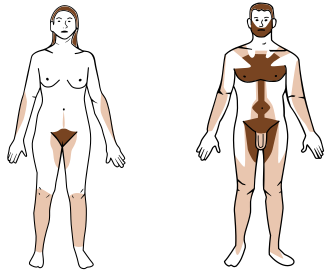Body hair
Body Hair[edit]

Body hair refers to the hair that grows on the human body. It is a characteristic of all mammals, including humans, and varies in density, length, and texture across different parts of the body and among individuals. Body hair is categorized into two main types: vellus hair and terminal hair.
Types of Body Hair[edit]
Vellus Hair[edit]
Vellus hair is the fine, short, and lightly pigmented hair that covers most of the human body. It is often referred to as "peach fuzz" and is less visible than terminal hair. Vellus hair helps to regulate body temperature by providing some insulation and aiding in the evaporation of sweat.
Terminal Hair[edit]

Terminal hair is the thicker, longer, and more pigmented hair that develops during and after puberty. It is influenced by androgens, which are hormones that increase during puberty. Terminal hair is found on the scalp, face, armpits, and pubic region, among other areas.
Development of Body Hair[edit]
Puberty[edit]

During puberty, the increase in androgen levels leads to the transformation of vellus hair into terminal hair in certain areas of the body. This process is known as androgenic hair development. In males, this includes the growth of facial hair, chest hair, and pubic hair. In females, terminal hair growth is typically less extensive but includes pubic hair and underarm hair.
Adulthood[edit]
As individuals reach adulthood, the pattern and density of body hair can continue to change. Factors such as genetics, hormonal levels, and age can influence these changes. Some individuals may experience increased body hair growth, while others may notice thinning or loss of hair in certain areas.
Distribution of Body Hair[edit]
Armpits[edit]

Armpit hair, also known as axillary hair, typically begins to grow during puberty. It serves a role in reducing friction between the skin of the underarm and the arm, and it may also play a role in the dispersal of pheromones.
Chest and Abdomen[edit]
Chest hair is more common in males and can vary greatly in density and pattern. Some men may have a full covering of hair, while others may have sparse or no chest hair. Abdominal hair often follows a pattern known as the "happy trail," which extends from the pubic area to the navel.
Arms and Legs[edit]


Hair on the arms and legs is common in both males and females, although it is generally more pronounced in males. The density and length of arm and leg hair can vary widely among individuals.
Facial Hair[edit]
Facial hair, including beards and mustaches, is a secondary sexual characteristic in males. It typically begins to grow during puberty and can continue to develop into adulthood. The style and grooming of facial hair can vary greatly across cultures and personal preferences.
Cultural and Social Aspects[edit]
Body hair has various cultural and social implications. In some cultures, body hair is considered a sign of maturity and masculinity, while in others, it may be seen as undesirable. Practices such as hair removal and grooming are influenced by cultural norms and personal preferences.
Related Pages[edit]
Ad. Transform your life with W8MD's Budget GLP-1 injections from $75


W8MD offers a medical weight loss program to lose weight in Philadelphia. Our physician-supervised medical weight loss provides:
- Weight loss injections in NYC (generic and brand names):
- Zepbound / Mounjaro, Wegovy / Ozempic, Saxenda
- Most insurances accepted or discounted self-pay rates. We will obtain insurance prior authorizations if needed.
- Generic GLP1 weight loss injections from $75 for the starting dose.
- Also offer prescription weight loss medications including Phentermine, Qsymia, Diethylpropion, Contrave etc.
NYC weight loss doctor appointmentsNYC weight loss doctor appointments
Start your NYC weight loss journey today at our NYC medical weight loss and Philadelphia medical weight loss clinics.
- Call 718-946-5500 to lose weight in NYC or for medical weight loss in Philadelphia 215-676-2334.
- Tags:NYC medical weight loss, Philadelphia lose weight Zepbound NYC, Budget GLP1 weight loss injections, Wegovy Philadelphia, Wegovy NYC, Philadelphia medical weight loss, Brookly weight loss and Wegovy NYC
|
WikiMD's Wellness Encyclopedia |
| Let Food Be Thy Medicine Medicine Thy Food - Hippocrates |
Medical Disclaimer: WikiMD is not a substitute for professional medical advice. The information on WikiMD is provided as an information resource only, may be incorrect, outdated or misleading, and is not to be used or relied on for any diagnostic or treatment purposes. Please consult your health care provider before making any healthcare decisions or for guidance about a specific medical condition. WikiMD expressly disclaims responsibility, and shall have no liability, for any damages, loss, injury, or liability whatsoever suffered as a result of your reliance on the information contained in this site. By visiting this site you agree to the foregoing terms and conditions, which may from time to time be changed or supplemented by WikiMD. If you do not agree to the foregoing terms and conditions, you should not enter or use this site. See full disclaimer.
Credits:Most images are courtesy of Wikimedia commons, and templates, categories Wikipedia, licensed under CC BY SA or similar.
Translate this page: - East Asian
中文,
日本,
한국어,
South Asian
हिन्दी,
தமிழ்,
తెలుగు,
Urdu,
ಕನ್ನಡ,
Southeast Asian
Indonesian,
Vietnamese,
Thai,
မြန်မာဘာသာ,
বাংলা
European
español,
Deutsch,
français,
Greek,
português do Brasil,
polski,
română,
русский,
Nederlands,
norsk,
svenska,
suomi,
Italian
Middle Eastern & African
عربى,
Turkish,
Persian,
Hebrew,
Afrikaans,
isiZulu,
Kiswahili,
Other
Bulgarian,
Hungarian,
Czech,
Swedish,
മലയാളം,
मराठी,
ਪੰਜਾਬੀ,
ગુજરાતી,
Portuguese,
Ukrainian